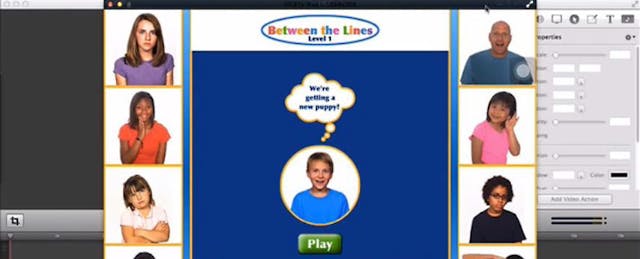Are you aware of facial expressions when someone is talking? Do you pay attention to body language or try to empathize with the speaker to understand his or her perspective?
Unfortunately, for kids with autism spectrum disorders, it can be hard to be aware of the subtle expressions and slang that we normally take for granted. For instance, perspective taking (as speech-language pathologist Jill Kuzma explains here) calls on many of the executive functions of the brain. It requires inhibitory control of our own thoughts and feelings in order to consider the perspectives of others, cognitive flexibility to see a situation in different ways, and the ability to consider someone else’s thinking alongside our own.
I came across Patti Hamaguchi, a speech-language pathologist and founder of Hamaguchi Apps, in 2011 when I was looking for apps to help my class understand directions. Her apps are each based on different aspects of speech and language disabilities for special needs students. One of the company’s first apps, First Words International HD, introduced receptive and expressive vocabulary activities for children with a Developmental Age of 2-3 years old.
I have kept in touch with Patti over the past year and a half. She knows my interest in speech apps as my older son has been classified with speech impairment.
Her “Between the Lines” series of apps, which comes in levels 1, 2, and advanced, was released in the fall of 2012. I tried Level 1 which is geared for students in elementary through middle grades. As the name suggests, the app offers a series of exercises organized around three objectives:
- listening and facial expressions;
- body-language and perspectives;
- everyday expressions, idioms and slang
(I find that it would also help students who are socially immature and those with with auditory processing disorders.)
This app is one of the main apps we use for our social skills group. Depending on the amount of free time I have, I use it for anywhere between one to five students. It has been about three months since I started using it, and I must say it is probably one of the most realistic apps I have used with both developmentally-delayed and autistic students.
The app allows teachers to tweak a number of settings, including how many answer choices are available, whether or not a bell sound (“ding!”) accompanies each correct response, and the sequence for how activities are displayed. There are also three “Reward Games” that can be enabled or disabled, depending on the teachers’ preference.
One good follow-up exercise after using the app is to have students use iMovie to record themselves re-enacting some of the scenes from Between the Lines. They can share that with others, and have their classmates guess his or her emotions or thoughts based on body language and expressions seen in the video. My students love to see themselves in actions and have their classmates give a verbal critique. And most importantly, I find that their grasp of perspective taking and empathy have improved.


